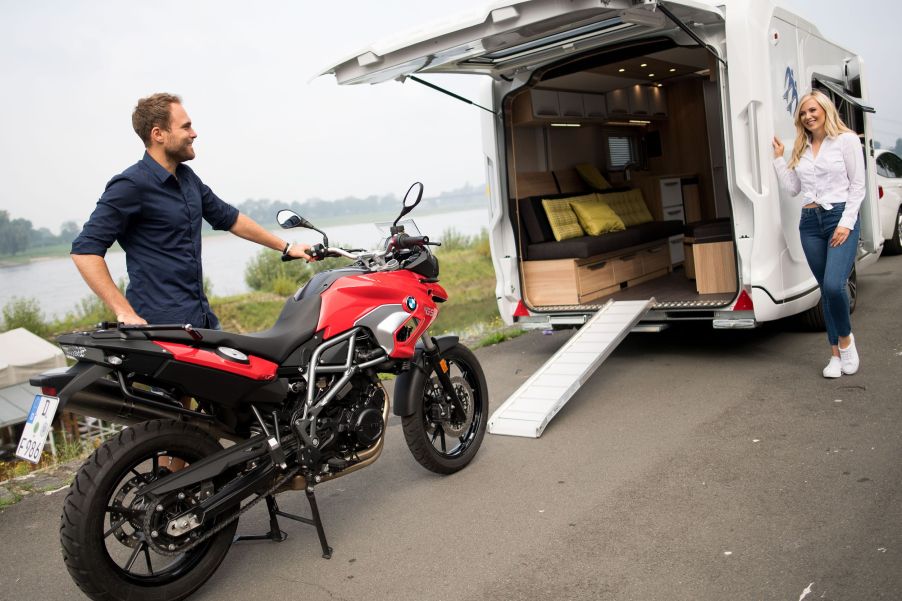
Don’t Do This if You Want to Move a Motorcycle With Your RV
Whether you’re staying at RV parks or boondocking, RVing doesn’t pause when you park. One of the main selling points of camper vans and RVs is experiencing the world outside of your parking spot. That’s why RVers often bring along other means of fun transportation. Boats are a common choice, as are bicycles. And if you don’t think you can handle a long-distance riding trip, you can always use your RV to bring your motorcycle to the riding spot. But as with hauling any kind of cargo, it’s very easy to do it improperly.
Don’t just load your motorcycle into your RV or camper van and hope for the best

Considering some RVs have enough onboard space to store a car, putting a motorcycle inside might seem trivially easy. And it might seem even easier for those with Class B camper vans. They’re often based on cargo vans, which are popular vehicles for track day enthusiasts; hence the term ‘track day van.’
However, as with loading your motorcycle into a truck bed, transporting it via RV or van is an involved process. And if it’s not done properly, you risk damaging your bike, your RV, and even yourself.
First, if you absolutely want to load your motorcycle into your RV, make sure the bike fits. And not just inside, but through the door, too. Secondly, check that your RV can handle your bike’s weight when it’s fully fueled. Going over an RV’s maximum payload capacity has serious consequences.
Once you’ve verified that your RV can safely accommodate your motorcycle, you have to load it in. The simplest and safest way is to roll the bike up a ramp. Park your RV in a low spot, secure its rear wheels, and get the longest ramp you can, Cycle World advises. Also, have a sturdy box or similar object to help you step up into the RV. And if you can, bring in more people to help.
However, the job’s not done when the motorcycle is inside the RV. You have to secure it so it moves as little as possible during the journey. Cargo vans like the Ford Transit often feature tie-down points for attaching sturdy tie-down straps. However, you can install aftermarket tie-down tracks, Cycle World notes. And for extra security, compress the motorcycle’s suspension and put a zip-tie or rubber band around the brake lever, The Bike Insurer says.
Don’t assume your RV can handle every kind of motorcycle carrier or trailer
Although you can theoretically transport your motorcycle inside your RV, that’s not the only method. Many RV owners move their bikes around using toy haulers or other travel trailers instead. And yes, there are motorcycle-specific trailers; you can even rent one from U-Haul.
Towing a motorcycle behind your RV in a trailer requires a similar level of preparation as hauling it inside, though. As before, the bike should be loaded onto the trailer with a ramp and secured using tie-down straps. However, instead of checking your RV’s payload capacity, you have to check its maximum towing capacity and trailer hitch. The latter is vital, a) to make sure it’s compatible with your bike trailer; and, b) certain hitches are designed around specific weight ranges. Also, make sure you have a trailer breakaway switch.
Loading your motorcycle onto a trailer isn’t your only option, though. If you want to carry bicycles outside of your car or truck, you use a bike rack. And motorcycles have an equivalent piece of equipment: the motorcycle carrier.
Like trailers, motorcycle carriers attach to your RV’s existing tow hitch or receiver. However, they’re significantly lighter, cheaper, and easier to live with, NADA Guides notes. Some motorcycle carriers also have built-in ramps for easier loading, The Drive reports. And there are even a few hydraulic-equipped carriers, aka ‘lifts,’ that eliminate the ramp-loading hassle, RVNStyle says. But before you load up, make sure your carrier accommodates your bike’s tires and its weight.
Safely towing or transporting a motorcycle requires research, prep-work, and care

Whether you haul your motorcycle inside your RV or outside using a carrier or trailer, the most important thing is to do your homework. And that doesn’t just mean knowing if your RV can handle the extra weight and how to safely secure the motorcycle. It also means being comfortable driving your RV with all of that extra ‘stuff.’
Towing a trailer requires extra concentration and care, including when parking. That’s why some RV owners prefer compact motorcycle carriers over trailers. But even if you bring your bike inside, it’s still a large and fairly heavy object. Extra care whilst on the move is a necessity. Plus, if you plan to use your van both as a bike hauler and a camper van, you’ll have to budget your space very carefully, RideApart muses.
None of this is meant to dissuade you from moving your motorcycle with your RV, though. It’s not impossible or even necessarily difficult. And with the right amount of forethought, it’s something that should make your next RV trip even more enjoyable.
Follow more updates from MotorBiscuit on our Facebook page.


